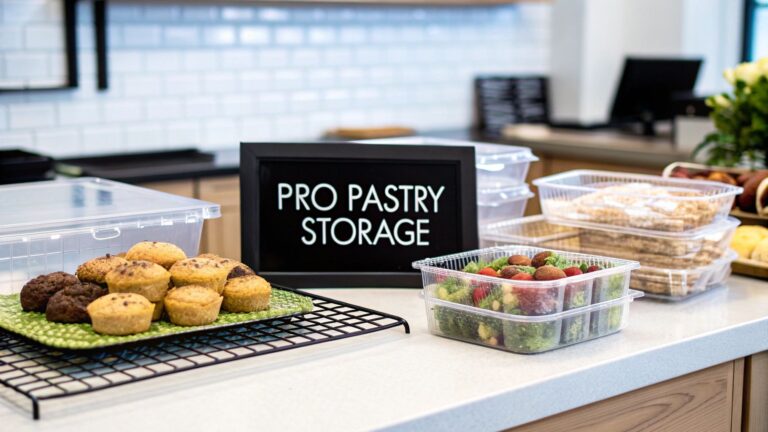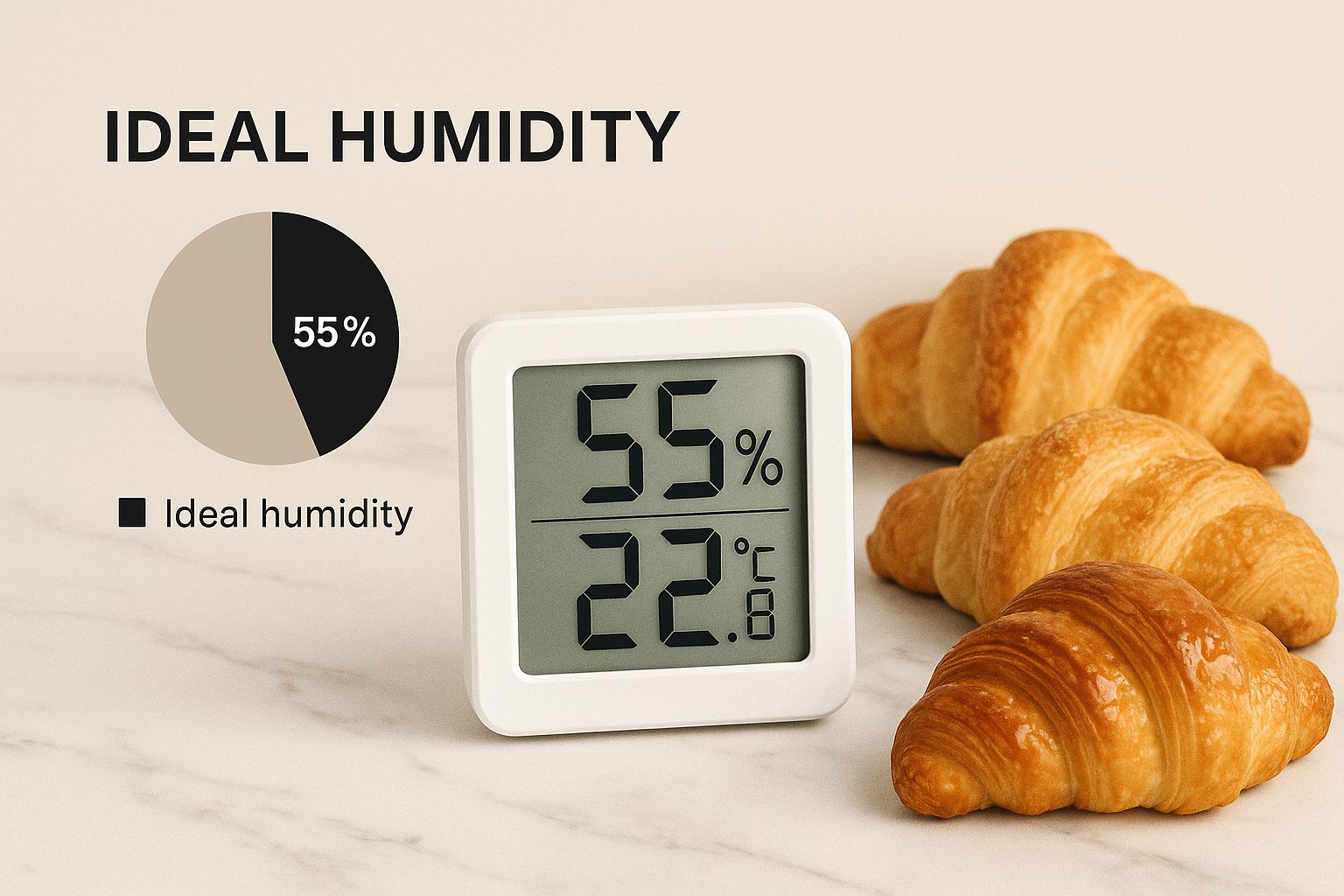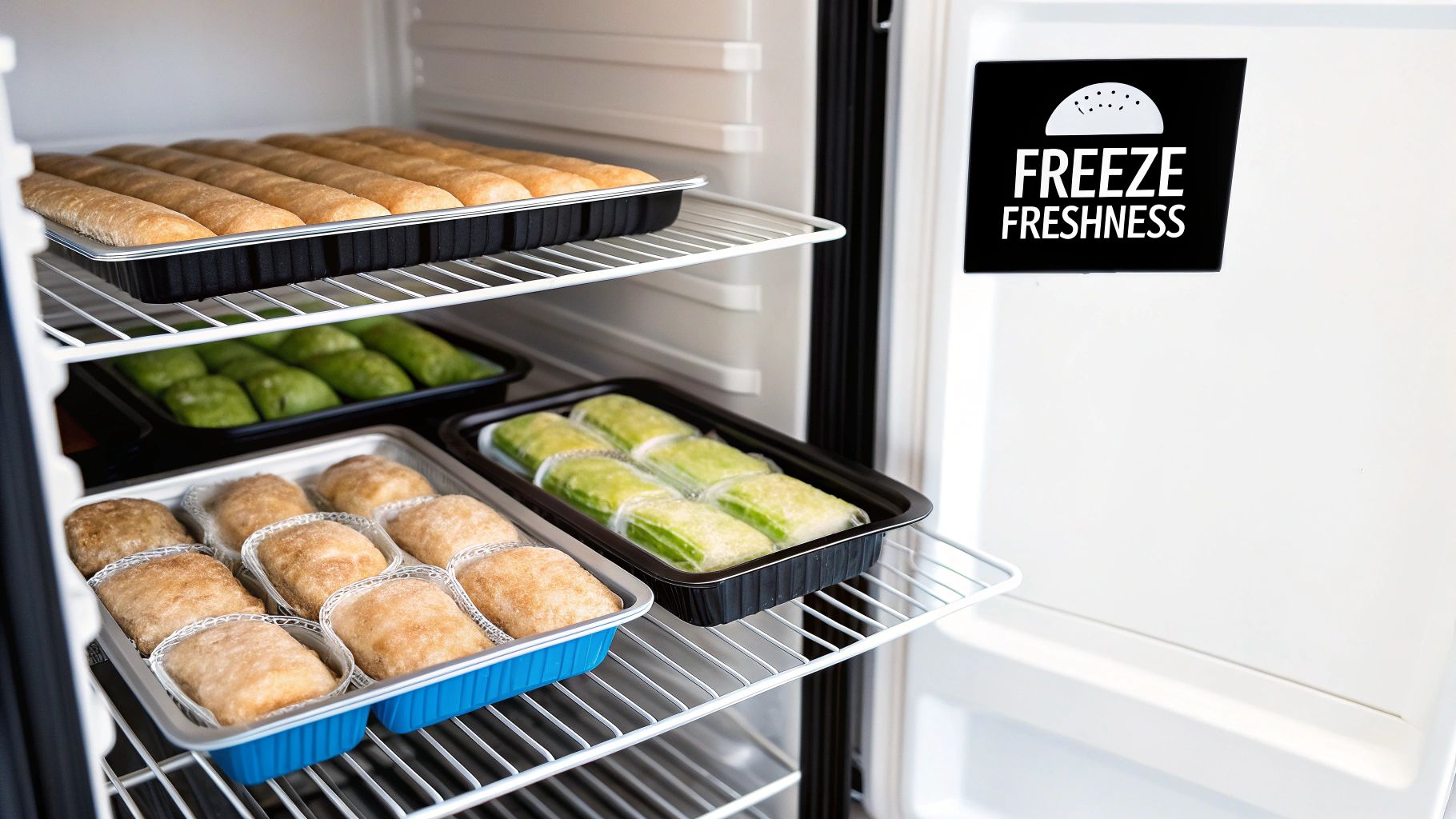Understanding What Makes Pastry Storage Actually Work
Storing pastries correctly isn’t as simple as placing them in a container. It involves understanding the science behind preserving freshness and flavor. This means considering how ingredients and storage environments impact a pastry’s shelf life. A delicate croissant, for instance, needs different care compared to a dense brownie. This section explores the essential elements of successful pastry storage, sharing professional baking insights and explaining the reasoning behind specific approaches.
Moisture Content and Its Role
Moisture content is a critical factor in pastry storage. High-moisture pastries, like cream puffs or fruit tarts, are susceptible to sogginess and quick spoilage if stored improperly. On the other hand, low-moisture pastries, such as biscotti, tend to become stale.
This contrast emphasizes the need for tailored storage methods. Interestingly, different storage approaches can offer valuable insights into preserving various items.
Fat Composition and Texture Changes
The fat composition of a pastry significantly influences its storage needs. Pastries rich in butter, like croissants and Danish pastries, are vulnerable to texture changes from temperature fluctuations.
Butter can soften and melt, diminishing flakiness. Maintaining a consistent temperature is vital for these buttery treats. High-fat pastries also absorb odors, requiring careful storage location planning.
The Impact of Ingredient Interactions
Understanding ingredient interactions is key to proper pastry storage. Some ingredients, like fruits, release moisture, impacting the surrounding components. This can lead to soggy crusts or filling breakdown.
For instance, a fruit tart with custard filling requires special attention to prevent structural damage. Proper storage has always been crucial for bakeries, especially with the industry’s growth to a $536.4 billion market in 2023, and pastries contributing significantly.
Recommended storage is typically 15°C to 20°C (59°F to 68°F) with 65% to 75% relative humidity. However, warmer climates might necessitate refrigeration at 4°C (39°F), potentially affecting texture. This highlights the balance between food safety and optimal texture.
Environmental Factors: Temperature and Humidity
Temperature and humidity significantly impact pastry storage. Temperature fluctuations cause condensation, leading to sogginess and bacterial growth. Humidity control is crucial, preventing dryness or excess moisture.
This balance requires more than just containers; it necessitates creating a suitable microclimate. This leads to exploring room temperature storage techniques, discussed in the next section.
Mastering Room Temperature Storage Like a Pro
Room temperature storage offers a convenient way to keep pastries fresh and readily available. However, it’s not as simple as leaving your baked goods out on the counter. This approach requires knowing which pastries do well in ambient conditions and how to create the best environment for them. Just like with olive oil, proper storage is crucial. Let’s explore the art of room temperature pastry storage and learn how to preserve both flavor and texture.
This infographic shows the ideal humidity for storing pastries using a digital hygrometer next to some fresh-baked goods. The thermometer highlights the importance of temperature control, along with humidity, for room temperature storage. Maintaining the right balance prevents dryness or excess moisture, which can affect texture and flavor.
Identifying Room-Temperature-Friendly Pastries
Not all pastries are the same when it comes to room temperature storage. Sturdier pastries like cookies, brownies, and some cakes handle ambient conditions well for a short time. However, delicate pastries with cream fillings, custards, or fresh fruit need more attention. A fruit tart, for example, will spoil faster at room temperature than a biscotti.
- Suitable for Room Temperature (Short-Term):
- Cookies (most varieties)
- Brownies and bars
- Pound cake, muffins, and quick breads (unfrosted)
- Less Suitable for Room Temperature:
- Cream-filled pastries (éclairs, cream puffs)
- Custard-based desserts (flans, tarts)
- Pastries with fresh fruit toppings
Creating the Perfect Microclimate
Maintaining the correct temperature and humidity is key for successful room temperature storage. Find a cool, dry spot away from direct sunlight and heat. This helps prevent pastries from drying out or getting soggy. It’s like creating a small, controlled environment similar to a professional bakery.
- Ideal Temperature: 65-70°F (18-21°C) is generally best. Avoid temperature changes, as these can cause condensation and texture problems.
- Humidity Control: Too much humidity causes mold, while low humidity dries out pastries. A relative humidity of about 50-60% is usually recommended.
Container Choices and Positioning Strategies
The right containers are important for keeping pastries fresh. Airtight containers prevent moisture loss and protect against odors. For pastries that get soggy easily, put a piece of parchment paper on the bottom of the container to absorb extra moisture.
How you place pastries in the container matters too. Store layered pastries flat to keep their shape. Stacking cookies directly on top of each other can damage decorations or make them stick together. This attention to detail helps your treats look and taste their best.
The following table provides a helpful guide for storing your pastries at room temperature:
Room Temperature Pastry Storage Guide
| Pastry Type | Storage Method | Container Type | Maximum Days Fresh |
|---|---|---|---|
| Cookies | Room Temperature | Airtight Container | 2-3 |
| Brownies | Room Temperature | Airtight Container | 2-3 |
| Muffins (unfrosted) | Room Temperature | Airtight Container | 2-3 |
| Pound Cake (unfrosted) | Room Temperature | Airtight Container | 2-3 |
| Fruit Tarts | Not Recommended | N/A | N/A |
| Cream Puffs/Eclairs | Not Recommended | N/A | N/A |
This table summarizes the best practices for storing common pastries at room temperature. Notice that items prone to spoilage or with delicate fillings are not suitable for this storage method.
Extending Freshness and Recognizing Warning Signs
Room temperature storage works for some pastries, but it’s important to watch their shelf life. Most room-temperature-friendly pastries are best within 2-3 days. Look for signs of spoilage, like mold, bad smells, or texture changes, no matter how long they’ve been stored. If you notice any of these, throw the pastry away to avoid getting sick. This helps you enjoy your pastries at their best and stay safe.
Refrigeration Strategies That Actually Preserve Texture
Refrigeration is key for many pastries, especially those filled with cream or custard. But it’s also a common source of mistakes, leading to less-than-ideal textures and soggy crusts. This section explores how to properly store pastries in the refrigerator, maintaining their quality and avoiding common pitfalls. It all comes down to understanding which pastries truly benefit from chilling and how to best handle them from fridge to table.
Preventing Condensation: The Enemy of Crispness
Condensation is public enemy number one when it comes to refrigerating pastries. It forms when warm air hits a cold surface, resulting in those dreaded water droplets. These droplets can easily ruin a crisp crust or make delicate pastries soggy, especially items like croissants or puff pastry.
The solution? Create a moisture barrier. Airtight containers are essential. They shield your pastries from the humidity fluctuations inside your refrigerator. For extra protection, wrap individual pastries in plastic wrap before placing them in the container.
Professional Wrapping Methods
How you wrap your pastries has a big impact on their texture. Simply tossing them into a container often isn’t enough, particularly for delicate treats.
- Plastic Wrap: Create a tight seal around individual pastries with plastic wrap before they go into a container. This prevents them from drying out and protects them from absorbing odors.
- Aluminum Foil: For pastries with savory fillings or those susceptible to strong smells, aluminum foil offers superior protection compared to plastic wrap.
- Parchment Paper: Place parchment paper between layers of pastries, especially cookies or bars. This prevents sticking and helps absorb any excess moisture.
Strategic Chilling and Serving Temperature
Some pastries, like cookie dough, actually improve with chilling. Chilling the dough before baking helps prevent spreading. However, most pastries are best enjoyed at room temperature or slightly warmed. This requires careful handling after refrigeration.
- Gradual Thawing: Remove pastries from the refrigerator 30-60 minutes before serving. This allows them to gradually reach room temperature and prevents sudden temperature changes that can negatively impact texture.
- Gentle Warming: Pastries best served warm, such as croissants or fruit turnovers, benefit from a quick warm-up in a low oven (around 300°F for 5-10 minutes). This restores their ideal texture. Avoid the microwave; it can make them soggy.
Avoiding Odor Absorption and Maintaining Quality
Pastries easily absorb odors from other foods in the refrigerator. Use airtight storage and consider placing activated charcoal or baking soda in your refrigerator to neutralize odors. Keep pastries away from strong-smelling foods like onions or garlic. These steps will help preserve the delicate flavors and aromas of your baked goods, ensuring a delightful experience.
Freezing Techniques That Preserve Quality Long-Term
Freezing your pastries is a fantastic way to enjoy them later, but it’s not as simple as tossing them in the freezer haphazardly. Some pastries freeze beautifully, while others, sadly, become icy messes. This section explores the techniques that will help you avoid freezer burn and ensure your pastries maintain their delicious texture and flavor. From wrapping to thawing, you’ll learn how to maximize your freezer’s potential for long-term pastry storage.
Selecting Freezer-Friendly Pastries
Knowing which pastries freeze well is the first step to success. Sturdy pastries like cookies, brownies, and unfilled cakes generally freeze well. However, delicate pastries with fillings like custards, cream, or fresh fruit often don’t fare as well. A fruit tart, for instance, might lose its textural integrity, whereas a simple cookie will likely survive the freezing process without a problem.
- Freezes Well:
- Cookies (most varieties)
- Brownies, bars, and loaf cakes
- Unfilled cakes (chiffon, sponge)
- Pie crusts (unbaked or pre-baked)
- Freezes Less Well:
- Pastries with delicate fillings (custards, whipped cream)
- Pastries with fresh fruit toppings or fillings
Professional Wrapping Techniques to Prevent Freezer Burn
Freezer burn happens when pastries are exposed to air and lose moisture, leaving them dry and unappetizing. Preventing this requires a multi-layered approach, similar to carefully wrapping a gift to protect it during shipping. The key is to create a tight seal.
- Wrap Tightly: First, wrap each pastry individually in plastic wrap, ensuring it’s pressed tightly against the surface to remove all air pockets.
- Aluminum Foil Shield: Add an extra layer of protection by wrapping the plastic-wrapped pastry in aluminum foil. This helps prevent freezer burn and guards against odor absorption.
- Airtight Containers: Finally, place the wrapped pastries in airtight freezer-safe containers or heavy-duty freezer bags. Squeeze out any excess air before sealing to create the most protective environment.
Timing and Temperature for Optimal Freezing
Maintaining the correct freezing temperature and duration is vital. Aim for a consistent 0°F (-18°C) or lower. Temperature fluctuations can cause ice crystals to form, which damage the pastry’s texture. A freezer thermometer can help ensure optimal conditions. While most pastries can be frozen for 2-3 months, remember that quality may gradually decline over time.
Thawing Techniques to Restore Original Quality
Thawing is as crucial as freezing. The wrong approach can ruin a perfectly preserved pastry. Different pastries require different thawing methods.
- Refrigerator Thawing: For most pastries, slow thawing in the refrigerator is best. This prevents condensation and helps maintain texture. Thawing time varies depending on size and type, but generally takes several hours or overnight.
- Room Temperature Thawing: Small pastries like cookies or brownies can thaw at room temperature. However, avoid thawing cream-filled or custard-based pastries this way, as they can become unsafe to eat.
- Oven Thawing: Some pastries, like croissants or turnovers, can be thawed and warmed simultaneously in a low oven. This helps restore their original crispy texture.
The following table provides a helpful overview of freezing best practices for various pastries.
Pastry Freezing Success Chart
| Pastry Category | Pre-Freeze Preparation | Maximum Storage Time | Thawing Method |
|---|---|---|---|
| Cookies | Wrap individually in plastic wrap, then store in an airtight container | 2-3 months | Room temperature or refrigerator |
| Brownies/Bars | Wrap tightly in plastic wrap and aluminum foil, then place in a freezer bag | 2-3 months | Refrigerator |
| Unfilled Cakes | Wrap tightly in plastic wrap and aluminum foil | 2-3 months | Refrigerator |
| Pie Crusts (unbaked) | Wrap tightly in plastic wrap and aluminum foil | 2-3 months | Refrigerator |
Following these guidelines will help preserve the deliciousness of your baked goods for months.
Specialized Storage for Different Pastry Families
Storing pastries isn’t a one-size-fits-all endeavor. Each type, from delicate croissants to sturdy biscotti, has its own unique storage needs. This section explores specialized techniques for different pastry families, ensuring your treats stay fresh and delicious. This specialized approach goes beyond generic advice, offering solutions for the specific challenges each pastry type presents.
Laminated Doughs: Croissants and Puff Pastries
Laminated doughs, known for their airy layers created by folding butter into the dough, require special care. Croissants and puff pastry are particularly sensitive to moisture and temperature changes. Imagine their delicate layers as a finely crafted stack of paper – moisture leads to sogginess, and temperature fluctuations melt the butter, ruining the texture.
- Room Temperature (Short-Term): Store in an airtight container for up to two days. Avoid using plastic wrap, which can trap moisture and make the pastry soggy.
- Freezing: Wrap tightly in plastic wrap, followed by a layer of aluminum foil, before placing in a freezer-safe container. This double wrapping protects against freezer burn and preserves the texture. Thaw overnight in the refrigerator for optimal results.
Choux Pastries: Éclairs and Profiteroles
Choux pastries, such as éclairs and profiteroles, possess a unique hollow structure that can quickly become soggy or dry. Their delicate nature, reliant on steam during baking, requires storage that maintains their crispness without impacting the filling.
- Refrigeration (Short-Term): Store in an airtight container, preferably lined with parchment paper, for up to two days. The parchment paper helps absorb excess moisture.
- Freezing (Unfilled Shells): Freeze unfilled choux pastry shells in an airtight container for up to two months. Fill them after they have thawed.
Delicate Treats: Macarons and Meringues
Macarons and meringues, both celebrated for their delicate textures, demand careful handling during storage. They are highly susceptible to humidity and temperature fluctuations. Macarons, with their buttercream or ganache fillings, are particularly sensitive to temperature changes.
- Macarons: Store in an airtight container in the refrigerator for up to three days. Allow them to come to room temperature before serving for the best flavor and texture.
- Meringues: Store in an airtight container at room temperature, ideally in a cool, dry area, for up to one week. Avoid storing them in damp areas, as humidity is detrimental to their texture.
Chocolate-Covered vs. Fruit-Topped Pastries
Chocolate-covered pastries have different storage requirements compared to fruit-topped pastries. Chocolate is sensitive to temperature fluctuations and can develop bloom (a whitish coating) if exposed to moisture or temperature changes. Fruit, conversely, releases moisture that can soften chocolate and make pastries soggy.
- Chocolate-Covered: Store in an airtight container at a cool room temperature, away from direct sunlight and heat, for up to three days. If refrigeration is necessary, ensure a tightly sealed container to prevent moisture damage.
- Fruit-Topped: Refrigerate in an airtight container lined with parchment paper. The parchment paper absorbs excess moisture from the fruit, preventing a soggy bottom. Consume within two days for optimal quality.
Layered Desserts
Layered desserts pose unique storage challenges due to the varying textures and fillings that need to remain distinct. Think of a beautiful layer cake – you want to avoid the frosting bleeding into the cake or the filling leaking.
- Refrigeration: Refrigerate in an airtight container, ensuring the layers remain stable. For cakes, consider using cake supports to prevent shifting during storage.
- Freezing: Freeze individual layers separately before assembling the dessert. This allows for flexibility and helps maintain the distinct texture of each component.
By following these specific guidelines for different pastry families, you can ensure your creations remain as delightful as when they first emerged from the oven. This attention to detail will elevate your pastry storage and help preserve their perfect textures and flavors.
Avoiding Storage Mistakes That Ruin Good Pastries
Even the most skilled bakers occasionally make storage errors that can transform perfect pastries into disappointments. This section explores these common mistakes, from using the wrong containers to timing errors that compromise quality. Understanding these pitfalls will help you maintain the freshness and deliciousness of your pastries.
The Perils of Improper Container Choices
Selecting the incorrect container is a frequent storage blunder. Using non-airtight containers exposes pastries to air, leading to staleness and dryness, particularly for items like cookies and biscotti. For example, storing a delicate croissant in a loosely covered container will cause it to lose its signature flakiness. On the other hand, airtight containers are essential for pastries with high moisture content, such as cream puffs, preventing them from becoming soggy.
Timing Errors That Compromise Quality
Storing pastries for too long, even in the right container, can negatively impact their texture and flavor. A sturdy brownie might last a few days, but a delicate fruit tart will deteriorate quickly. Understanding the proper storage time for each type of pastry is essential. Overlooking early signs of spoilage, like mold growth or unusual odors, can also lead to unpleasant surprises.
The Dangers of Cross-Contamination
Storing different kinds of pastries together can lead to cross-contamination of flavors and textures. Pastries with strong aromas, such as those containing spices or nuts, can transfer their scents to more delicate pastries. Imagine storing a fragrant cinnamon roll next to a plain croissant. The croissant might absorb the cinnamon scent, changing its intended flavor profile. This principle also applies to textures. Storing a moist pastry next to a dry one can cause the dry pastry to absorb moisture and become soggy.
Early Warning Signs and Troubleshooting Techniques
Recognizing the early indicators of storage problems can help you rescue your pastries before they become inedible. For example, condensation inside a container indicates excess moisture and the potential for sogginess. Texture changes, such as a once-crisp pastry becoming soft, also point to improper storage.
Fortunately, some troubleshooting methods can revive pastries that haven’t been stored correctly. Gently warming a stale cookie in a low oven can sometimes restore some of its original texture. However, preventing these problems through proper storage practices is always the best course of action.
Real-World Scenarios and Practical Solutions
Consider this scenario: you’ve baked a batch of beautiful macarons, but improper storage causes the delicate shells to become sticky. This frequent problem arises from high humidity or insufficiently airtight storage. The solution? Store macarons in an airtight container in a cool, dry location, making sure they aren’t exposed to changes in temperature or humidity.
Another example: your cream puffs have become soggy overnight. This likely results from storing them in an airtight container before they cooled completely or from not lining the container with parchment paper. To avoid this, ensure your cream puffs are entirely cool before storing them, and use parchment paper to absorb any excess moisture. These practical solutions address common storage issues, ensuring your pastries stay fresh and delightful.
Professional Tips for Maximum Freshness and Quality
Elevating your pastry storage goes beyond simply using any old container. It’s about understanding the nuances of different pastry types and using techniques that maintain their unique qualities. This guide unveils professional secrets for extending freshness, maintaining texture, and preserving the delicious flavors that define exceptional pastries.
Invest in Specialized Storage Equipment
While airtight containers are essential, consider specialized equipment for optimal results. A pastry display case, for example, not only showcases your creations but also provides a controlled environment that helps maintain freshness. Humidity-controlled cabinets offer precise control over moisture levels, crucial for delicate pastries like macarons. Even a simple cake dome can significantly extend the life of a frosted cake, protecting it from air and maintaining its moisture.
Natural Freshness Extenders
Certain natural ingredients can also help extend the freshness of your pastries. Apple slices placed in an airtight container with cookies or brownies can help maintain moisture. A piece of bread added to a container of cookies, on the other hand, absorbs excess moisture, preventing them from becoming soggy. Finally, a small container of baking soda in the refrigerator can absorb odors, protecting your pastries.
Timing Strategies for Maximum Lifespan
Timing is key in pastry storage. Knowing how long each type can be stored at room temperature, in the refrigerator, or the freezer is crucial. Cookies might last a few days at room temperature, but cream-filled pastries should be refrigerated and eaten within a day or two. Freezing pastries when they are at their freshest locks in quality. However, be sure to follow proper thawing techniques to restore their original texture.
Assessing Pastry Freshness
Knowing how to assess pastry freshness can prevent disappointment. Check for visual cues like mold growth or changes in color and texture. A dry or hard texture means the pastry is stale, while excessive moisture suggests it wasn’t stored properly. Use your sense of smell, too. Off-odors are a sign of spoilage. If a pastry looks, smells, or feels off, it’s better to be safe than sorry and discard it.
Refreshing Stored Pastries
Sometimes you can revitalize stored pastries. Gently warming stale cookies in a low oven can restore some of their texture. Spritzing a slightly dry cake with simple syrup can add moisture. However, refreshing isn’t always possible, especially with delicate pastries. Knowing when to refresh and when to discard is key for quality.
Presentation Techniques for Stored Pastries
Stored pastries still deserve to look their best. Arrange them attractively on a serving platter. Garnish with fresh fruit or a dusting of powdered sugar to enhance their visual appeal. Even a simple sprig of mint can elevate a plain brownie. These small touches make a big difference in how your pastries are presented.
Implementing a Comprehensive Storage Plan
Creating a comprehensive storage plan involves understanding the specific needs of each pastry type. This includes designated areas for room temperature, refrigeration, and freezer storage. Label containers with dates to track freshness and regularly check your stored goods for any signs of spoilage. A structured approach maximizes freshness and quality, ensuring every bite is delicious.
Are you looking to upgrade your packaging? Visit MrTakeOutBags.com for a wide selection of quality packaging solutions for bakeries and food service businesses.






Comments are closed.